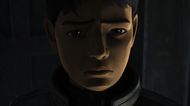The arc of Asajj Ventress in Star Wars: Tales of the Underworld doesn’t open with a crawl or a grand orchestral theme. It begins with her body being lowered into the sacred waters of Dathomir and a love already lost. May the 4th didn’t bring a spectacle, but something quieter and more enduring.
Author’s note: This review will be published in two parts. The one you’re reading now covers the first three episodes focused on Asajj Ventress. The second will dive into the next arc, centered on Cad Bane. Each three-episode segment forms a self-contained narrative, allowing for a more in-depth look at each character’s journey.
Asajj Ventress, long absent from the saga, is returned to the galaxy not through triumph, but sacrifice. This anthology, unlike the previous ones, doesn’t seek to elevate heroes. It offers space to the forgotten, the broken, the ones who kept moving even when the story no longer followed.
Asajj Ventress and the price of resurrection
The first arc, centered on Asajj Ventress, is a slow and spectral journey that reframes everything we thought we knew about her. Death doesn’t free her, yet she is offered a choice. The Nightsisters offer her life again, but at the cost of her heart’s desire. Yes, Star Wars: Revenge of the Sith feelings, all over again.
This is the same ancient tension at the core of Star Wars, the pull between power and peace, love and duty. But here, that tension is not shouted. It's lived in silence, in weariness, in the way Ventress avoids looking directly at what she feels.

A mythic lens on the underworld
This underworld is not just the criminal galaxy's underside. It nods to the mythic one, the space between life and death, the shadows where memory and regret settle like dust.
Every part of this tale is saturated with that atmosphere. You feel the loneliness in each frame, the weight of choices long made. And unlike many stories that use resurrection as a reset, this one treats it like what it is: a consequence. Asajj Ventress does not return unchanged. She comes back unsure of what she is even supposed to fight for.
Star Wars: Tales of the Underworld - Visuals you can almost touch
What makes this arc unforgettable isn’t the action, though there is plenty. It's the way the animation carries grief without drowning in it. Every environment feels tactile, lived in.
The lighting alone conveys more emotional truth than some scripts manage in pages. 2025 Star Wars animation is, at this point, reliably excellent, but Star Wars: Tales of the Underworld raises the bar by doing something braver. It slows down and lets us feel.
Enter Lyco Strata
When Asajj Ventress meets Lyco Strata, the story sharpens. He is young, Force-sensitive, on the run from the Empire, and speaks of someone she tried to bury in her mind and past: Quinlan Vos. Lyco reminds her of who she was when she still believed in someone.

Lyco tells her about the Jedi Path, a secret network that helps Force-sensitive individuals find safety. It's hope in motion, quiet and cautious. Ventress listens but doesn’t quite believe him, well, not until he risks his life to save hers. Their dynamic never leans on cliché. There is no forced mentorship, no sudden bond. Instead, there is mutual survival, tension, and eventually, trust.
When she tells him the truth, that she was Count Dooku’s lead assassin, that she served darkness with her whole being, it doesn’t come as much as a confession. It sounds more like resignation.
Old ties, frayed trust
The story continues to deepen as they seek out the network, and the past keeps clawing back. Latts Razzi enters the picture, a figure from Ventress’s bounty hunting days, still calculating, still dangerous. Their interactions are sharp and frayed, full of unsaid betrayals and unresolved debts. Every alliance feels temporary. Every plan carries a fracture line.
What is remarkable is how the show lets the weight of history shape every scene without spelling anything out. There are no clunky reminders, no exposition dumps. If you know the lore, it deepens. If you don’t, the emotion still hits. This is storytelling that trusts its audience.

And that trust pays off in the moments between fights. It's Star Wars in its very essence. In the canyon where water is collected. In the standoff that could have been avoided if war hadn’t broken everyone’s instincts. In the quiet realization that Ventress no longer wants revenge, nor absolution. Just peace.
The Jedi who still believes
The supporting characters are sketched with just enough detail to matter. The old man at the homestead, the raiders with their sense of justice, and even Latts herself, none of them falls flat. But it is Lyco who holds the emotional thread, the reason this story doesn’t collapse into nihilism. He isn’t naive. He just hasn’t lost his compass. And that, more than any Force power, is what makes him feel like a Jedi.
After some duels, battles and confrontations, in the very final scenes, everything slows again. They reach a landing site where a ship waits to extract Force-sensitives. Lyco is offered a future.
He asks Ventress to come with him, however, she declines his offer. She's no longer looking for the man she loved. That search ended in silence. Lyco deserves a future. She doesn’t say she doesn’t. She just lets him go.
But then he returns. The ship lifts off, and she assumes he left. Instead, he comes back, and not out of obligation, but out of choice. She asks if he missed the transport. He says no. He just thought he would be safer with her.
They ride off together. He speaks of friendship. She says nothing. The beast moves. He holds onto her. The rest is dust.
What stays after the fight ends
That quiet is the heart of this story. It's not a redemption arc. It"s not a backdoor pilot. It"s a love letter to the ones who do not fit the mold. A story about scars that stay. About surviving long enough to choose something different.
Asajj Ventress’s story doesn’t end with victory. It ends with company. That, finally, is enough.
Rating with a touch of flair: 5 out of 5 drops of water in the desert.
